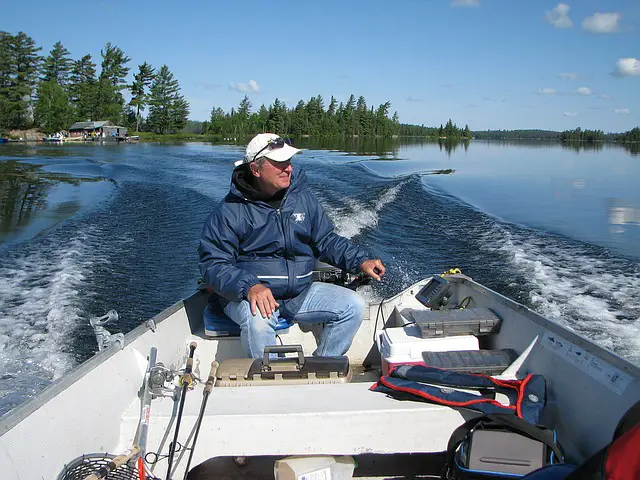
Trolling Flies for Big Trout| Trout and Steelhead on Trolled Flies
Think “trout fishing” and you probably think “flies”. Even if you are not a fly fisherman you know that they are one of the most productive methods for landing trout consistently. But think “trolling for trout” and flies are probably one of the last lures that come to mind. This is a mistake.
If you want to catch trout, including trophy wall hangers, regularly it is hard to beat flies. This is true whether on a mountain stream or trolling your favorite lake.
The advantages of trolling flies
The biggest reason you should try trolling flies is that they are effective. Time after time flies, especially streamers, catch big trout. Why? Because they imitate the baitfish trout are looking for and do so in a realistic, action-filled way that trout cannot resist.
Another reason to give flies a try is that it is one of the easiest methods of trolling you will find. Unlike conventional fly fishing, there is a short learning curve, and no special equipment needed.
WARNING: There’s a lot of information about this subject you’ll probably want to come back to. No one expects you to remember all these tips. We know your time is precious, so we really tried to over-deliver in value for you. Additionally, we frequently update reports like this, so you’ll want to stay up to date with any changes or additional tips we include for you.
We found that the easiest way to save and bookmark this report so you can come back to it later is to share it on your favorite social media platform, especially if you use your phone to get important tips like the ones in this report here…
Click on your favorite social media buttons to remember this page now!
In A Hurry?
If you don’t have much time to read this detailed report, simply use the links below to quickly find the best fly kits for trolling on Amazon. You can be assured we only choose the best products…
Best Complete Kit – Ventures Fly Co Trout Flies
Best Budget Kit – Crotch Wet/Dry Trout Flies
Best Midrange Kit – Bassdash Trout Flies
The Fly Kit Comparison Table










#ad / Images from Amazon Product Advertising API
When to use flies
Trolling flies for trout can produce at any time during the year, however, the preferred time is right after ice out. If you want to catch big trout hit the water as soon as the ice has cleared.
Why is this period so productive? This is when the surface temperature is cool enough that trout will be high in the water column and well within reach of smaller, shallow diving flies. Plus, at this time of the year trout are hungry and feeding on smaller baitfish, insects, and invertebrates. This is exactly what flies imitate.
Best Flies For Trolling Trout
There are two features you need to consider when selecting flies for trolling; mimicking the natural prey trout want and producing the action necessary to make the meal irresistible.
Trout feed on a variety of prey depending on the size of the fish you are targeting. Smaller trout prefer larvae, insects, small invertebrates, and smaller fish. Larger trout, those over 15″-16″, prefer larger minnows (including other trout), crustaceans, leeches, and worms.
When it comes to achieving the best action choose flies with plenty of feathers or fur that will flutter in the water. You can enhance the action by choosing flies that are specially designed for trolling as they include small spinners or propellers in the design.
Wet Flies For Trolling Trout
The great thing about trolling with wet flies is you can fish them in any depth of water.
Primarily wet flies represent young waterborne insects. Lowe and behold a trout’s diet is 90% primarily these types of insects.
Since a wet fly can be customized to represent the local hatch, no wonder why they’re so effective at catching trout!
Types of wet flies
There are six styles of wet flies you should know about:
- Wingless wet flies
- Winged wet flies
- Soft hackle flies
- Fuzzy nymph flies
- San Juan Worm
- Wooly Bugger
- Streamer
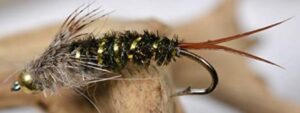
Wingless wet flies – Also commonly known as ‘nymphs’, are created from soft hair fibers, spikey hackle over a natural colored body structure.
These flies can be found weighted or unweighted and it’s also common to see ‘legs’ attached to these flies.
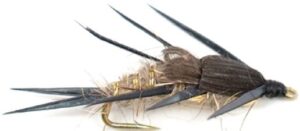
Winged wet flies – built similar to the wingless wet flies, but have additional ‘wings’ tied on that can be made from mallard, pheasant, peacock, or some other type of bird feather.
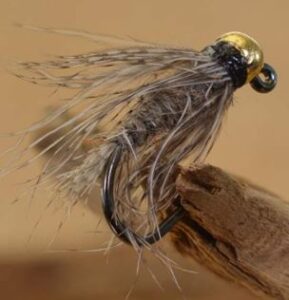
Soft Hackle Flies – These narrow and slender body flies have a collar of water-absorbing hackle from partridges, hen, or grouse.
Anglers love to use these flies because of the unique action it displays underwater. The action is best described as breathing, feeding, or subtle undulation. It’s incredibly natural and this fly works best in the slower current.
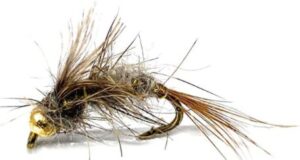
Fuzzy nymph – This style of wet fly is made from loose dubbing and mammal fur as the collar.
This style of fly is really interesting because it doesn’t include hackle, so the fly gets its action from the fuzzy dubbing strands.
This ugly fly is the most ‘buggy’ appearing and downright catches trout.

San Juan Worm – Not really a ‘fly’ but created to look like a worm! These flies can come in a variety of colors and sizes.
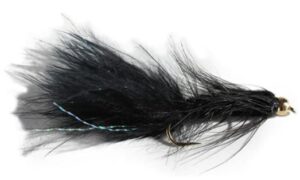
Wooly Bugger – In my opinion, a Wooly Bugger is a hybrid mix of the wingless wet, fuzzy nymph, and a streamer. They can be very small or very large, depending on what size prey the trout in your lake prefer.
The wooly bugger can mimic a fish or an insect.

Streamer Fly – is designed to look like a larger insect or even a minnow. Works amazing on trout, salmon, steelhead and bass
Dry Flies For Trolling Trout
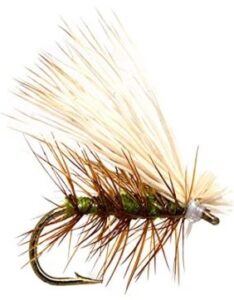
A dry fly is a fly that floats on top of the water and does not get wet.
Dry flies will mimic a newly surface insect during a ‘bug hatch’. Dry flies can also mimic other insects that fall into the water such as grasshoppers, bees, beetles, spiders, caterpillars, etc.
During a hatch, thousands of insect larvae sprout their wings and swim to the surface. Most hatches occur during the summer months and it’s best to keep this in mind when you consider what fly to use.
A dry fly’s buoyancy can be helped by spritzing on a neutral oil (grapeseed or vegetable oil) or with a different form of water repellent.
Most dry flies are classified as freshwater flies.
The setup
Flies can be trolled using the same equipment you already use to target trout on a local stream. If you already have a favorite trolling setup chances are you can use that as well.
Rod – The ideal rod is 7′-8 ½’ in length as this will allow you to keep the lines clear of the boat and prevent tangling. A medium-light, moderate action rod will provide the flex needed to absorb hard strikes.
Reel – any spinning or level-wind reel will do. Most anglers find that level-wind reels are easier to manage and having a line counter helps but is not necessary. Lightweight spinning reels can add to the sport of landing big trout in light tackle. Whatever reel you prefer, be sure to have an extra-large spool as trolling requires more line than other methods.
Line – Unless you will be lead lining the preferred material for trolling flies is either monofilament or braided.
Braided allows for extra strength with reduced diameter. However, the braided line does not stretch so it will need to be paired with a softer action rod to avoid tearing hooks free.
Monofilament offers excellent shock absorbing qualities but will be a bit thicker, which can cause problems when fishing deeper as it is more buoyant.
Leader– There are two choices for leader material, fluorocarbon, or monofilament.
Fluorocarbon is the most popular as it is less visible, however, it can weaken when flexed repeatedly.
Monofilament is more flexible and even though more visible this does not seem to be a problem when trolling.
Trolling Techniques
Flies can be used with any trolling method, however, some work better than others. These methods take advantage of a fly’s action and resemblance to natural bait.
Planers
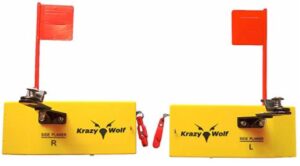
This method is similar downriggers in that it uses a mast, reel, and secondary line to deploy the planer boards. However, there is no weight and the entire outfit is more compact making it a better choice for smaller boats. It also makes it a good choice for use with smaller lures like flies. The biggest advantage is the ability to space lines further apart, covering a larger search area.
- Attach planer board to mast cable and place in the water
- Feed out cable until the board is desired distance from the boat (20-35 yds)
- Place fly in the water with the drag set
- Attach the release clip to the fishing line and cable ring and place in the water
- Feed fishing line, allowing the ring to slide out the cable until 2-3 ft. from board
- When a fish strikes the clip will release allow fishing line to fall in behind the boat. If a smaller fish strikes and the clip does not release give the fishing line a slight tug.
Flat Lining
This is the least complicated method of trolling for trout. It requires no special equipment and can be done from almost any boat, including canoes and kayaks. It is remarkably effective on smaller waters or when trout are running at shallow depths. It is also well suited for use with flies.
- Attach a fly to the line. To target deeper fish, use a larger stream, weighted bead-head fly, or add a slip shot to the line.
- Let out 25-50 ft. of the line while moving at slow speed. When using smaller flies, it may be necessary to put the line out more than you would with other lures to avoid the boat’s turbulence.
- Place the rod in the holder and wait for a bite.
**You can position lines at different distances and depths to search for fish.**
Dodgers
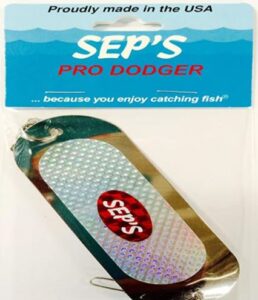
Dodgers resemble large spoon lures. When used while trolling they add both action and depth, allowing you to target large trout like deeper water. They are available in a wide range of sizes, allowing you to target everything from lake trout to kokanee.
- Attach the dodger to the mainline via a barrel swivel
- Attach 18-inch leader to the opposite end of dodger via a barrel swivel
- Attach fly to the leader
The Lake Troll In-line Flasher

A lake troll consists of a flasher and multiple in-line spinners. This set up combines all the best features of the other methods and presents an offering trout cannot resist. Here is a basic rig, you can mix it up as needed based on local conditions:
- Attach lake troll to the mainline via a barrel swivel
- Attach 30-inch leader to lake troll via a barrel swivel
- Attach action disc and bobber stop
- Attach fly
** If you need to get your line deeper add a keel weight before lake troll. **
Trolling For Trout In The Wind

photo: @ nitish-meena
Windy conditions can make or break your day when you’re trolling.
however sometimes the wind is just too strong, or coming in from the wrong direction. It makes trolling seem more like an unpleasant chore.
Recently I stumbled across a amazing new item that helps me slow my boat while maintaining a ninja silent presentation and keeps my lure in strike zone loner.
This product is called a drift sock!
It’s really easy to use and you attach it to the aft or the side of the boat.
Best of all since its not electric, it doesn’t use up all my battery!
Even if you never used a drift sock before, the job of deploying one is easy once you learn a few basics. If you have no idea what a drift sock is and would like to learn more more – start here… I wrote the complete blueprint report on Drift Sock Basics – What It Is & How To Use It [2021 Quick Start Guide]. Where I go into more detail on What Does A Drift Sock Do and Why Use A Drift Sock?
The drift sock we highly recommend is made a company called Mythik Outdoors. They won the best overall quality award and can be used on the vast majority of boats or kayaks.
The drift sock comes in a complete kit. Meaning, you get a insanely durable drift sock, a floating harness, a collapsing cord and a water resistant storage bag. – It’s really cool.
We you’re interested in this you can read all the reviews from actual Amazon customers. Click here!
Where to troll in windy conditions?
There is some debate on where to troll for deep trout in windy conditions.
Some say, it doesn’t matter where you troll for deep trout because the wind doesn’t have a major effect on their positioning or feeding habits.
On the other hand some anglers say just the opposite. Their argument is the wind is typically warmer than the water and that can not only warm the water (which the trout don’t like), but also deprive that water of oxygen (because warmer water does not have enough oxygen).
Personally, I find that logic slightly flawed.
It would have to be very windy for several days of the same warm conditions and never change direction in order to possibly have the effects of changing the oxygenation of deep water.
Many times wind will change direction and there are high-pressure and low-pressure systems that roll through any given lake where I feel it doesn’t have that much of an effect.
I guess, if you’re struggling at one end of the lake and you’re faced with windy conditions, head over the opposite side of the lake and see if the water temperature is cooler… who knows, it may work!
Bonus Tip
Add an action disc for more action – an action disc is a small cupped or cone-shaped device that is attached to your fishing line directly in front of a fly or plastic bait when trolling.
As the line is dragged through the water the cup fills with water and eventually tips to one side to release pressure.
This in turn adds action to the fly or lure. Because the action disc will randomly tip one way or another the fly will also move in an erratic, random manner.
If using an action disc do not use a fluorocarbon line. This type of line does not stand up to repeated bending, something the action disc will cause between 3 and 15 times per minute depending on speed.
Other Trout Trolling Related Articles
- How To Troll for Trout [A Beginner’s Guide]
- 10 of the Best Trolling for Rainbow Trout Techniques [Tips Without Downriggers]
- Trolling for Trout with Downriggers (Best Practices & More – Secrets From A Retired Fishing Guide)
- How To Troll Flies For Trout [Our 15 Best Tips]
- What’s The Difference Between Rainbow Trout Vs Steelhead?
FAQ
Can you troll with a fly rod?
Yes, you can use a fly rod when trolling. The long, limber design allows anglers to feel even minute hits and will easily absorb the shock of harder strikes.
However, there are disadvantages. Many anglers prefer to hold the rod when trolling with a fly rod, rather than placing it in a holder.
While this does allow the angler to better detect bites it does make it difficult to manage multiple lines.
Plus, fighting a large fish that maybe 50-feet. or more from the boat can be a test of your fishing skills.
How fast should I troll a fly?
Most trolling is done at speeds of 1-2 mph. When using flies this is a good starting point, however, you may need to slow down to achieve peak action from the fly.
When adjusting speed watch your fly for signs of twisting, skipping on the surface or running in a straight line without any action.
If any of these are observed slow down until proper action is achieved.
Will trolling flies work for other species?
Yes. Although flies are most associated with targeting trout or salmon, they are effective on almost any species.
Anglers routinely catch everything from panfish to pike on flies so be ready for anything.